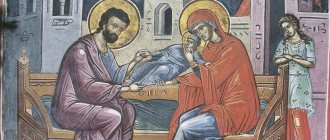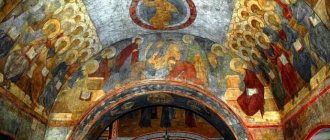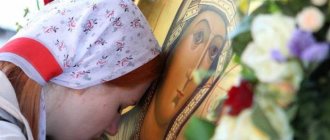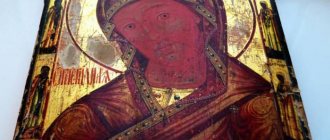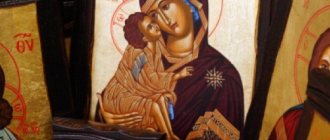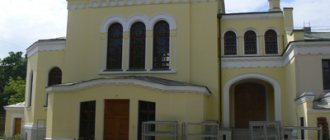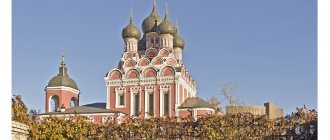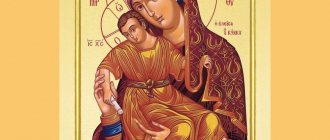There are many outstanding icons in the history of Russia. For centuries they protected the country from enemy invasion, healed the suffering, and protected from fires and natural disasters. The most significant of them are presented below.
The most revered Russian icons
| N | Icon | Location | date |
| 1 | Vladimir Mother of God | Church of St. Nicholas | 5th century |
| 2 | Hodegetria of Smolensk | lost in 1943 | 1046 |
| 3 | Bogolyubskaya Mother of God | Vladimir-Suzdal Monastery | 1155 |
| 4 | Gatekeeper (Goalkeeper) | Athos Iveron Monastery | XI-XII centuries |
| 5 | Sign of the Blessed Virgin Mary | St. Sophia Cathedral of Veliky Novgorod | 12th century |
| 6 | Fedorovskaya Mother of God | Epiphany-Anastasia Cathedral | 12th century |
| 7 | Nikola Mozhaisky | Tretyakov Gallery | XII-XIII century |
| 8 | Kursk Root Mother of God | Synodal Znamensky Cathedral of New York | 1295 |
| 9 | Spas Eleazarovsky | Eleazar Monastery | 1352 |
| 10 | St. Nicholas (Ugreshskaya) | Tretyakov Gallery | 1380 |
| 11 | Tikhvin Mother of God | Tikhvin Dormition Monastery | 1383 |
| 12 | Donskaya Mother of God | Tretyakov Gallery | 1382-1395 |
| 13 | Transfiguration | Tretyakov Gallery | 1403 |
| 14 | Trinity | Tretyakov Gallery | 1411-1427 |
| 15 | Pskov-Pechora Mother of God | Pskov-Pechorsky Monastery | 1520 |
| 16 | Pochaevskaya Mother of God | Pochaev Lavra | 1559 |
| 17 | Kazan Mother of God | lost | 1579 |
| 18 | Samistrelnaya | lost in 1917 | 17th century |
| 19 | Blessed Xenia of St. Petersburg | Smolensk Church of St. Petersburg | XX century |
| 20 | Saint Matrona of Moscow | Pokrovsky Monastery | XXI Century |
Icon of the Vladimir Mother of God
According to chronicle sources, the icon was painted by the Evangelist Luke himself in the 5th century. It was brought to our country at the beginning of the 12th century and presented as a gift to Prince Mstislav. She gained fame as a miracle worker after she diverted invaders from the Russian capital three times. It is believed that this happened on June 3, 1521 (deliverance from Makhmet-Girey), July 6, 1480 (deliverance from Akhmat) and September 8, 1395 (deliverance from Tamerlane). All these dates are now celebrated by the Orthodox Church as Great Holidays in her honor. The icon of the Vladimir Mother of God is the most famous of the existing ones. Placed in the Museum-Church of St. Nicholas in Tolmachi.
The most important icons for the home
Each icon is a prototype of a saint, and it is worth having in the family. However, among the many icons available today, there are some that you cannot do without. Here are a few icons, a list and photographs of which we provide below. It is not necessary to have a large number of them in your home iconostasis. It’s good when there are those representatives to whom we most often turn.
Image of Jesus Christ
Find out what awaits you today - Horoscope for today for all zodiac signs
A place of honor is dedicated to this icon. It should be like a team. Prayers to him protect you from illness or help you fight a serious illness. If this image of the crucified Lord helps you calm down in difficult situations, then it suggests the right decision to prevent troubles and unworthy actions.
It is best to hang it in the eastern part of the house or in an apartment, if the layout of the house allows. If not, then it is better to choose a place where it is easiest to pray and no one can disturb you.
Icons with the face of the Virgin Mary
It is good to have an icon of the Mother of God in every family. It is known that in Orthodoxy there are many images of the Mother of God. Each of them has its own strength and special meaning. Some of them protect the home, some heal, some comfort and support the strength of the weak and troubled.
Seven-shot icon of the Mother of God
It is believed that it protects the house from evil guests and evil spirits. It is a good defense against family scandals, protects against evil tongues and is feared by thieves. To achieve this, the shrine should be placed close to the main entrance, sometimes right above the door, so that whoever enters the house will be face to face with it.
Everlasting color
Upon request, we have prepared an application for smartphones “Orthodox Calendar”. Every morning you will receive information about the current day: holidays, fasts, days of remembrance, prayers and parables. Free download: Orthodox calendar 2022 (available on Android)
Guardian of youth and beauty. It often helps to maintain love and good relationships. Helps not to lose hope, frees you from destructive temptations. Place it in a convenient place.
Inexhaustible Chalice
If there are alcoholics or other people in the family who are addicted to various bad habits, this picture is simply necessary. A person prays to him when he wants to get rid of his bad inclinations or turns to a loved one or close person for help in this matter.
Icon of St. Nikolai Ugodnik
Almost always present next to the image of the Savior. People turn to him when they find themselves in a difficult life situation or become seriously ill.
When you need to make some important decision for yourself, or in case of complete despair, also send your prayers to the Miracle Worker.
Face with the image of the Holy Trinity
The icon brings peace to your home and family. He provides help in difficult times. It is best to place it against the front wall or in the east corner of the room.
If a person is overwhelmed with negativity and bad thoughts do not leave him, it is worth praying to the Holy Trinity. It eliminates bad mood and cleanses from sins.
Icon of the Blessed Virgin Mary of Smolensk
This icon was brought to Russia in the 11th century. It is recognized as miraculous, protecting and fencing the western borders of the country. The celebration of the icon takes place on August 10. It was delivered to Russia from Greece, however, to this day it is unknown who made it. Among the most famous miracles attributed to this icon of the Most Holy Theotokos is the fencing of Smolensk from the invasion of the army of Batu Khan in 1239. Its prototype is considered irretrievably lost during the occupation of Smolensk by Nazi troops in 1941. There are only a few lists left.
"First steps"
This image with a rather unusual iconography can be classified both as an icon of the Lord and as an image of the Mother of God.
The most unusual detail of this icon is that Christ, the Son of Mary, is no longer a baby, as we are accustomed to seeing him in classical iconography. The Savior is written by a touching child who takes his first steps under the close attention of a caring Mother. He extends His arms to Her, and she carefully insures Him in his first attempts at independent steps. This is a very gentle image, full of tenderness. Before the image, they pray for the children, asking the Queen of Heaven to protect them and protect them from all evil.
A similar icon exists in Greek and Romanian versions. In Greek (presented above), the Savior himself first stood on his feet and takes his first steps towards the Mother of God, and she stretches out her arms towards him.
You can find the Romanian version yourself. In it, the Most Pure One carefully places the Divine Infant on the ground, facing away from her, and gently pushes him in the back, at the same time supporting him so that the child takes a few steps.
Icon of Our Lady of Bogolyubsk
The creation of the icon dates back to 1155; it is revered as miraculous and is considered one of the most ancient in Christianity. In 1946, a restoration was carried out, which partially restored the badly damaged image. Already in this century, it suffered again - due to improper storage it was affected by a fungus. Today, the icon of Our Lady of Bogolyubskaya is located in a special room of the Vladimir-Suzdal Monastery. According to experts, the new restoration could cause irreparable harm to it.
Icon of the prophet Jonah released from the belly of a whale
This is a very rare icon; to look at it you need to walk through more than one city. The icon depicts an Old Testament story. The Lord called His prophet to go to the sinful city of Nineveh and preach the true faith there. However, the prophet Jonah did not want to fulfill the will of God; instead, he decided to sail on a ship on a long journey. The Lord got angry and ordered the elements to teach the rebellious man a lesson. Sent a terrible storm. Jonah understood the will of God, but it was too late. Then the prophet ordered to throw him out of the ship; as soon as this was done, the storm calmed down, but the misfortunes did not stop there. A giant whale swam out of the abyss of water, which, by order of the Most High, swallowed Jonah. For three days and three nights the prophet cried and prayed to the Lord to have mercy and release him from the belly of the whale. The Lord heard and forgave. The whale disgorged an intact Jonah onto the shore. Praising God for his mercy, the prophet Jonah went to Nineveh. He converted many pagans to the true faith. Here is such an extraordinary image, serving as a reminder to us how important it is in this life to fulfill the Will of God and adhere to His Commandments.
Icon of the Iveron Mother of God
In the 9th century, the icon was kept in the house of a faithful widow, who saved it by hiding it in the sea. Two centuries later, the icon of the Iveron Mother of God appeared to the monks of the Iveron Monastery on Mount Athos. There are many legends associated with it. Allegedly, one day a certain robber hit the icon with a sword and blood poured out of it. Subsequently, the robber repented and took monastic vows in the monastery, where he ended his days in prayer and fasting. The icon is located in the Iveron Monastery in the Greek Athos. Her list was solemnly delivered to Moscow in 1648.
Not Idle, or the Womb of the Divine Child
This icon, which I would like to talk about, was revealed in Georgia, in the Dibri monastery during the restoration of ancient frescoes, and is called the Non-Idle One, or the Womb of the Divine Child . On it, the Mother of God was written during the period of bright anticipation of the Infant Christ. This is a story from the pages of the Holy Gospel, which tells how the holy righteous Joseph learned that the Virgin betrothed to him “was with child of the Holy Spirit” and wanted to secretly release Her (Matthew 1:18-19). The Mother of God stands with her right hand raised to her head, wiping away tears, and with her left hand she points out to Joseph that “she does not know her husband” and is a Virgin (Luke 1:34). The ruling bishop of the Russian-Urbnis diocese of the Georgian Orthodox Church, Metropolitan Job (Akiashvili), gave his blessing in 2001 to write a list of the “Non-idle” icon depicted on the fresco, which was done by Hieromonk John Okhanashvili. In front of the icon they pray for the gift of children and their health.
Icon of the Blessed Virgin Mary of the Sign
Dates from the 12th century. In 1170, the troops of Prince Dmitry Bogolyubsky besieged Veliky Novgorod. When its inhabitants carried out a religious procession along the walls, the icon was pierced by an accidentally fired arrow and began to cry in front of thousands of soldiers. At the sight of this miracle, the superstitious warriors fled in horror from the city walls. Today, the image of the holy miraculous icon is kept in the St. Sophia Cathedral of Veliky Novgorod.
Sword of Prince Dovmont
Dovmont was a Lithuanian prince, but, having fled from internecine wars in his homeland, he settled in Pskov, where he was baptized and began to be called Timofey. For more than 30 years, Dovmont served the city, and after his death he was canonized as a local saint. The commander's sword became a state relic. For a long time it was kept in the Trinity Cathedral; after the revolution, the blade was transferred to the Pskov Museum. Dovmont's sword is the only medieval sword in Russia whose history is reliably known and recorded.
Icon of Our Lady of Feodorovskaya
It is not known for certain when exactly this image was painted. It is believed that the icon of the Mother of God of Feodorov was first mentioned in chronicles dating back to the 12th century AD. Throughout its history, it was miraculously saved from fire several times. In 1613, it was with her that Mikhail Romanov was blessed to reign. His mother, nun Martha, blessed him. Today the icon is kept in Kostroma, in the collection of the Epiphany Convent. Experts in the field of iconography classify it as the Eleus (Tenderness) type.
All-Seeing Eye of God
Symbolic-allegorical composition from the Holy Scriptures .
The icon depicts several circles, in one of them there is Christ, in the other there are elements of a human face, the Mother of God. More circles - the sky, angels... It is difficult for an unprepared person to understand what it is. The image of the All-Seeing Eye means the eternal will of God, His Omniscience and Omniscience.
Before this image you can pray for any need. Confession of sins, preparation for Communion, repentance - any prayer can be read in front of the icon.
Carved Icon of St. Nicholas the Wonderworker "Mozhaisk"
Known as "Nikola Mozhaisky". First mentioned in 1495. It is a carved sculpture of St. Nicholas the Wonderworker with a sword in his hand. Served as a prototype for a huge number of icons of a later period. Until recently, it was kept in the Mozhaisk Kremlin, but due to its special historical significance it was moved to the Tretyakov Gallery.
Icon of Our Lady of Kursk Root
This work of church art was found in 1295 while picking mushrooms in the forest near Kursk. When the icon was raised, a spring of clean water immediately began to flow from the ground in the place where it lay. There is a legend according to which it was broken in half during the Mongol-Tatar invasion. As soon as the two parts were placed one against the other, they grew together miraculously, so much so that not even a trace of fracture remained. In 1920, at the height of the civil war in Russia, the icon was taken out of the country by the troops of Baron Wrangel. In 1957, it was placed for storage in the Znamensky Cathedral of the Synod of Bishops in New York, where it remains to this day.
Golden Gate of Vladimir
The Golden Gate of Vladimir was built in 1164 under Prince Andrei Bogolyubsky. They led to the richest princely-boyar part of the city. In the old days, the gates were covered with sheets of gilded copper, which gave them a special solemnity. This was precisely the reason for the theft of the gates in 1238, when Vladimir was taken by the Mongol-Tatars. The gate, however, did not go far; while crossing the frozen Klyazma, the ice cracked and the gate sank. The doors were never found.
Unfortunately, due to fires and enemy invasions, the Golden Gate has reached us in a greatly altered form. They were restored several times, so that the ancient parts of the structure include only a wide passage arch with powerful side pylons and a battle platform above them, preserved in fragments.
Icon of the Savior of Eleazar
The icon dates back to the 14th century and is now housed in the collection of the museum-reserve of the city of Pskov. In 2010, it was transferred for permanent storage to the collection of the Spaso-Eleazarovsky Monastery, where it remains to this day in the Cathedral of the Three Saints. Revered as miraculous. According to legend, it was found in 1352 on the ashes of the temple. It is assumed that it was originally used as a cell room due to its small size. The style of icon painting is considered transitional from the pre-Mongol period to the style of the second half of the 14th century.
Holy MartyrChristopher Pseglavets
A saint unjustly forgotten by the modern world. Perhaps it was forgotten because of its unusual iconographic appearance. On the icon the saint is written with the head of a dog. Of course, this image is symbolic. There are several explanations for the zoomorphic image: the first says that, captured during the battle by the Romans, a wild native of the Berber tribe (which is located in Egypt) was so strong and ferocious that he looked not like a person, but like an animal. The second interpretation of the image comes from the opposite - a certain Berber warrior, who bore the name Reprev before baptism, was so stately and beautiful that he could not avoid a sinful life, then he, having believed in Christ, begged God to disfigure him beyond recognition. God heard the prayers of His servant and made his face like the muzzle of an animal.
At the end of his life, the saint performed many miracles and led pagans to the true faith. For this, Emperor Decius Trajan hated him and ordered him to be brutally tortured. The torture was unsuccessful, and the martyr had to be beheaded. This is the amazing life of the early Christian saint, and no less amazing is his iconographic image.
- There were many opponents of painting icons with a dog's head. One of them, for example, was St. Dmitry of Rostov. At his request, a case was even opened in the Holy Synod, but it never got off the ground, and this problem was not officially resolved. In some churches, the image of St. Christopher was painted with a human head, and in some shops they continued to offer believers the original version with an animal head, which testifies to us the diversity of religiosity of Russian believers in the 17th-19th centuries.
Icon of St. Nicholas (Ugreshskaya)
According to legend, she appeared in 1380 to Dmitry Donskoy during his transition to the Kulikovo field. As history testifies, a monastery was subsequently built on that site, and the image itself was kept there until its closure in 1925. Nowadays, the icon of St. Nicholas (Ugreshskaya) is in Moscow and is part of the collection of the Tretyakov Gallery.
Ladder of John the Climacus
The composition is based on the plot of the Eastern Christian monastic work “The Ladders” .
Abbot John had a vision - a staircase to heaven. This is a symbol of spiritual ascent to God. 30 steps, and Christ is waiting at the top. This figure is not accidental. The text of “The Ladder” mentions 30 sins that every monk will have to overcome before achieving salvation. Some of them successfully overcome obstacles, others have already fallen into the abyss.
Angels and demons fly nearby. The icon also depicts John himself, pointing the monks to the stairs as the only path to salvation. Prayers to John Climacus are read in the name of strengthening faith in the Lord.
Icon of the Tikhvin Mother of God
It is believed that this icon was found in 1383, it happened in the city of Tikhvin. Revered as miraculous. There is a legend according to which it was this icon that, through its intercession, helped save the monastery of the Assumption of the Blessed Virgin Mary from the invasion of Swedish invaders in 1613. The canons of iconography classify this work of art as a type of Hodegetria icon. This type is characterized by a letter depicting the communication of the Virgin Mary with the infant Christ. Now this creation is in the Assumption Monastery in the city of Tikhvin.
Virgin Mary with mother and grandmother
In Greece you can find a rather rare icon of the Queen of Heaven with the image of not only the Lord in her arms, but also her other close relatives.
According to Tradition, the grandmother of the Virgin Mary was already distinguished by deep piety and the Blessed Virgin was named “Mary” by her parents in honor of her.
We know about the misadventures of the holy Godfathers Joachim and Anna from the description of the feast of the Nativity of the Virgin Mary. They could not have children for a long time and promised God that if they had a child, they would dedicate him to the Lord. This is how little Maria was born.
Icon of Our Lady of the Don
This icon is double-sided - on its reverse side the Assumption of the Blessed Virgin Mary is depicted. The authorship of the work is not known for certain - according to one version, it was written by the monk Theophanes the Greek. There is a legend according to which the icon of Our Lady of the Don was presented by the Cossacks as a gift to Dmitry Donskoy before the Massacre of Mamaev (September 8, 1380). Today it is kept in the Tretyakov Gallery. Once a year, on September 1, the image is manually transferred to the Donskoy Monastery, where the icon takes part in a festive church service.
Tree of Jesse
The iconographic plot on the topic of the genealogy of Christ is also not deprived of the attention of icon painters.
Artists all over the world tried to recreate the composition not only on canvas, but also in mosaic and fresco form. The genealogy is depicted along the line of the Blessed Virgin Mary. It symbolizes the continuity of the Old and New Testaments.
The family tree grows from the chest of Jesse, and all the ancestors of Christ are indicated on it. The icon is located on the island of Andros in the Greek monastery of St. Nicholas.
Interesting fact: despite its popularity all over the world, this composition has not become widespread in Russian art. One of the famous ones is “The Tree” of 1568 (by Dionisy Grinkov).
Icon of the Transfiguration of the Lord
Written in 1403. The authorship is attributed to Theophanes the Greek, although no documentary evidence of this fact has been found. Moreover, according to the results of recent research, the icon of the Transfiguration of the Lord belongs to the brush of another 15th-century painter. Its creation is associated with the reconstruction, recreation of the lost appearance and consecration of the Cathedral of the Transfiguration of the Savior in Pereyaslavl Zalessky. In the last century, the famous icon was transferred to the storage room of the Tretyakov Gallery in Moscow, where it is kept to this day.
Trinity
Andrei Rublev wrote this Trinity in the first half of the 15th century, it is considered his most famous creation - over the six centuries of its existence, it was updated five times. However, when restoration work was carried out in 1919, a new copyright layer was discovered. The icon depicts three angels sitting at a table with a bowl on which is the head of Taurus. All the figures are in motionless contemplation with their gazes directed towards eternity. Currently, the Trinity is kept in Moscow, in the collection of the Tretyakov Gallery.
Spas Good Silence
This icon can hardly be called popular among believers; it is quite rare .
It depicts Jesus in angelic rank before the incarnation. A young man with wings in light clothes, there is nothing in his hands, they are humbly folded crosswise. In Russia, such a plot began to be used in the 15th century. This icon is common among monasticism. She exemplifies silence and “mental prayer.”
Icon of Tenderness of Pskov-Pechersk
It is a reproduction of the icon of the Mother of God of Vladimir, made in 1521. According to legend, it was she who saved Pskov from death during the siege by the troops of the Polish King Stephen in 1581. Remembrance Day is celebrated on October 7 - on this day in 1812, the Pskov-Pechersk Icon of Tenderness was in the troops of the I Corps of the Russian Army during the siege of the city of Polotsk by Napoleon’s army. The city survived then. The icon is considered miraculous; blind people have been healed more than once through prayer. Nowadays it is located in the iconostasis of the Assumption Cathedral of the Pskov-Pechersky Monastery.
Icon of Our Lady of Pochaev
The first chronicle mentions of it date back to 1559. It was then that the noblewoman Anna Goyskaya presented the image as a gift to the monks of the Pochaev Dormition Lavra. The miraculous “Our Lady of Pochaev” was recognized in 1675. It was then, in the period from July 20 to 23, that the Lavra was besieged by the Turks. It is believed that the intercession of the miraculous icon became the cause of salvation. In addition to this incident, many more cases of her miraculous intercession were noted. According to church archives for the period from 1721 to 1832. 539 miracles occurred. Today, the image is still in storage at the Assumption Pochaev Lavra in Ukraine.
“Ostrobramskaya”
This icon got its name from its location above Ostra Brama, one of the gates to the capital of Lithuania, Vilnius. The image is revered not only by Orthodox, but also by Catholics, and is noted for many miracles.
The iconography is unusual in that it is part of the plot of the Annunciation. Here the Blessed Virgin had just received from the Archangel Gabriel the news of the future miraculous conception of the Savior.
We do not see the archangel on the icon, but the Mother of God, humbly accepting the will of God, folds her hands crosswise on her chest and bows to thank the heavenly messenger for the amazing and kind message.
Icon of the Kazan Mother of God
In 1579, the Mother of God appeared three times in a dream to the girl Matryona. It was she who called for the icon to be dug up from the ashes of the fire in Kazan, which caused the death of most of the city. After excavations, the icon was found at a depth of one meter, on July 8, 1579. Now there is a nunnery on this site.
Today this icon is one of the most famous in the country. It is believed that her patronage helped the warriors of Dmitry Pozharsky expel hordes of Poles from the country. On July 12, 1904, the “Kazan Mother of God” was stolen from the Bogoroditsky Monastery and later destroyed.
Miracle-working icons - guardians of the Russian land
Dear friends, I am glad to meet you again!
In February, the main secular holiday is Defender of the Fatherland Day. This year, February is marked by another great date - the 75th anniversary of the victory of Soviet troops at Stalingrad in the Great Patriotic War.
At all times, in the most difficult moments for our Motherland associated with enemy invasion, people asked for protection from miraculous icons.
A miraculous icon - in the Orthodox Church - an iconographic image revered as a source of miracles of various kinds, most often healings, help in fires and in war.
The eight miraculous icons of the Mother of God are most revered in Russia: Vladimir, Kazan, Tikhvin, Smolensk, Pochaev, Don, Iverskaya (Moscow) and “Znamenie” (Novgorod).
Three of them - Vladimir, Tikhvin and Smolensk - are among the oldest in the world. According to legend, they were written by the holy Apostle and Evangelist Luke.
These icons are glorified by a variety of miracles and signs. And yet they gained deep popular love precisely during wars and enemy invasions. These were icons-protectors, icons-guardians of the Russian land. They were lifted onto the fortress walls during the enemy's assault on the city, they were carried around the camp before the battle, and they were carried into battle with them. This was the case on the Kulikovo Field and at Stalingrad.
Until now, protective icons stand guard over our land.
The Tikhvin icon preserves the northern borders, the Iverskaya icon preserves the southern borders. Pochaevskaya and Smolenskaya protect our Motherland from the west. In the east, the Kazan Icon of the Mother of God protects Russian lands. And in the center the image of the Vladimir Mother of God shines. Let me tell you about three of them.
The Vladimir Icon of the Mother of God is one of the main shrines of the Orthodox Church. It has been in Moscow for more than six centuries. How much has this shrine seen! The foundation of a new Russian state - first Vladimir-Suzdal, then Moscow. The invasion of conquerors in different centuries - Tamerlane, Napoleon, Hitler...
The Vladimir Icon of the Mother of God was sent to Rus' in 1131 from Constantinople and placed in Vyshgorod, in the Maiden Monastery. One of the remarkable monuments of ancient Russian literature - “The Tale of the Miracles of the Vladimir Icon of the Virgin Mary” - tells about the transfer of the icon from Vyshgorod to Vladimir by Prince Andrei Bogolyubsky.
The image was being transported to Rostov, but suddenly, 12 versts from Vladimir, the harnessed horses of Prince Andrei stopped. The horses began to be whipped, but they did not move. The princely convoy stopped, they pitched a tent, and the prince fell asleep. In a dream, the Mother of God appeared to him with a scroll in her hands and said: “I don’t want My image to be carried to Rostov, but place it in Vladimir, and in this place, in the name of My Nativity, erect a stone church.” This was in 1159.
In 1395, when Tamerlane, having ravaged Ryazan, headed towards Moscow, destroying and devastating everything around, it was decided to move the Vladimir Icon to Moscow. Moscow Metropolitan Cyprian with the clergy, the princely family and people met the icon outside the city, on Kuchkovo Field, and solemnly transferred it to the Assumption Cathedral of the Moscow Kremlin. Tamerlane, having stood with his army for two weeks in one place, suddenly became afraid, turned south and left the Moscow borders: “Punished by the power of the Blessed Virgin, he fled.”
The icon was never returned to Vladimir; it was left in Moscow. Since then, the great shrine - the Vladimir Icon - has repeatedly saved the Russian capital from troubles and enemy invasions. In 1451, the army of the Nogai Khan approached Moscow. The Tatars set fire to the Moscow suburbs, but the city was never captured. During the fire, Saint Jonah performed religious processions along the walls of the city. Warriors and militia fought with the enemy until nightfall. The small army of the Grand Duke at this time was too far away to help the besieged. The next morning, as the chronicles tell, there were no enemies near the walls of Moscow. They heard an extraordinary noise, decided that it was the Grand Duke with a huge army, and retreated. After the Tatars left, the prince himself cried before the intercessor - the icon of Vladimir.
The Smolensk Icon of the Mother of God is a shrine of Western Rus'.
In Greece, the icon became famous for many miracles, and the image came to Russia in 1046: the Greek emperor Constantine Porphyrogenitus, marrying his daughter, Princess Anna, to the Chernigov prince Vsevolod Yaroslavich, blessed her with this icon on her journey. That is why the Smolensk icon is called “Hodegetria” (“Guide Book”).
According to legend, the Smolensk Icon was also painted by the Apostle Luke during the earthly life of the Blessed Virgin Mary. This is a blessing given by the Mother of God to Western Rus'. It was from the west that enemies often came to Russia, and the Smolensk icon always stood guard over the Russian land . The Smolensk Mother of God defended Smolensk from the hordes of Batu Khan and showed her intercession during the Patriotic War of 1812 .
On August 5, 1812, when Russian troops were leaving Smolensk, the icon was taken to Moscow. On the eve of the Battle of Borodino, this image was worn around the camp to strengthen and encourage the soldiers for a great feat.
On August 26, the day of the battle of Borodino, three images of the Mother of God - the ancient image of the Smolensk Hodegetria, together with the Iveron and Vladimir icons of the Mother of God, were carried around the capital in a procession of the cross, and then sent to the sick and wounded soldiers in the Lefortovo Palace so that they could venerate the shrines. Before the retreat from Moscow, the icon was transported to Yaroslavl.
After the victory over the enemy, on November 5, 1812, by order of Kutuzov, the Hodegetria icon was returned to Smolensk to its native Assumption Cathedral.
During the occupation of the city by the Nazis in 1941, the ancient icon disappeared. Now in its place there is a miraculous list (copy) of the Smolensk image, dating back to 1602.
The Kazan Icon of the Mother of God is one of the most revered icons of the Russian Orthodox Church. Before her they pray for the salvation of Russia during hostilities, for the soldiers.
During the Time of Troubles, a militia was formed in Nizhny Novgorod under the leadership of Prince Dimitry Pozharsky and Kuzma Minin. The troops are heading to Moscow; on the way, Kazan residents join them and hand over a list of the icon of the Kazan Mother of God. Before the storming of the Moscow Kremlin, in 1612, the militia endured a three-day fast and prayed to the image of the Virgin Mary.
During the siege of Moscow, Archbishop Arseny of Elasson was there. According to contemporaries, St. Sergius of Radonezh appeared to him and said that thanks to the intercession of the Mother of God, the invaders would leave the capital, and Russia would be saved. In the fall of 1612, Moscow was indeed liberated from the Poles by militias. On October 25 of the same year, a religious procession was held in the Kremlin, the main icon of which was the icon of the Kazan Mother of God.
The victory of the Russian army in 1612 is not the only case when the intercessory power of the icon of Our Lady of Kazan was manifested. Chronicles mention her help during the battle of Poltava (1709); the image also played an important role in the war with Napoleon in 1812. Field Marshal Mikhail Illarionovich Kutuzov prayed for victory before the face of the Mother of God. Particularly noteworthy is the successful battle near Vyazma, which coincided with the day of veneration of the icon. Then Russian troops managed to defeat Napoleon's army - this was the first major victory over the invaders after the French left Moscow.
The Kazan Mother of God came to the aid of Russia at the beginning of the Great Patriotic War. Orthodox Christians all over the world then prayed for the salvation of Russia.
Despite the rejection of religion by the Soviet authorities, the image was delivered to besieged Leningrad. The priests carried the icon along the outskirts of the city, and the Northern capital managed to withstand the complete blockade for 872 days. Despite all attempts, the fascist army was never able to take the city. The intercession of the icon of Our Lady of Kazan during the Great Patriotic War also helped in the Battle of Stalingrad. The day before the battle, a prayer service was held in front of the holy image in the city. The victory at Stalingrad was a turning point in the entire Second World War.
The defeat of the Germans near Moscow is also a true miracle, revealed by the prayers and intercession of the Mother of God. Unprecedented frosts struck, the likes of which had not been seen for 140 years. The Germans fled in panic. Many of them suffered from frostbite.
In 1942, at the height of the Great Patriotic War, posters were issued with a quote from I.V. Stalin: “Let the courageous image of our great ancestors inspire you in this war.” All posters depicted the Great Orthodox defenders of the Russian land - Alexander Nevsky, Dmitry Donskoy, Kuzma Minin and Dmitry Pozharsky. This was a turning point for the country in terms of the attitude of the authorities towards the church and religion. Everywhere during the war, the names of the Holy Defenders of the Russian Land - Alexander Nevsky and Dmitry Donskoy - were painted on tanks and airplanes.
There certainly were real miracles during wars. And the strength and valor of the Russian soldiers was supported by the prayers of the Orthodox Church and the intercession of the Mother of God.
And the Ryazan region has patron saints and intercessors. I wrote about them in a previous post. This is St. Vasily of Ryazan and the Theodotyevskaya Icon of the Mother of God, which is located in the Boris and Gleb Cathedral.
Prayer before the icons of the Mother of God saved Russia more than once.
For all Orthodox Christians, the icons of the Mother of God to this day embodies the idea of the prayerful intercession and intercession of the Most Holy Theotokos for the world.
Icon of Our Lady of Seven Arrows
The discovery of the revealed image took place in the bell tower of a temple in the city of Vologda. For a long time no one noticed the icon of the Mother of God of the Seven Arrows, mistaking it for one of the floor boards. According to legend, it was found by a peasant from the district of the city of Kadnikov, who was the first to notice it. It was recognized as miraculous in 1830, during one of the cholera epidemics. Today it is considered lost. One of the most famous copies is located in Moscow, in the Church of the Archangel Michael. This is the “Seven Arrow” icon, which is considered myrrh-streaming.
Goden Cross
The Goden cross is an image of the crucified Christ, made of linden wood. The shrine was found in 1423 in the Sahota swamp. Nicholas the Wonderworker appeared to the shepherds, and soon a temple was built at the site where the cross was found. A large number of miracles are attributed to the Goden shrine, and perhaps it is because of this that the cross suffered so much damage in Soviet times. After unsuccessful attempts to burn or poison the tree with acid, the cross was thrown into the swamp, but several parishioners pulled the shrine out of the swamp and hid it in the Chrysostom Church. At the beginning of the 21st century, the cross was restored, and now you can worship it in the Church of St. John Chrysostom, which is located in the Yaroslavl region, in the village of Godenovo.
Icon of Blessed Xenia of St. Petersburg
They began to venerate the saint during her lifetime, despite the fact that she was officially canonized in 1988. There are quite a few handwritten images of her, the most famous is in St. Petersburg, in the Smolensk Church. The saint's day of remembrance is celebrated on February 6, the day of glorification is June 6. Today parishioners ask the saint to help in the birth of children, their upbringing and education.
Image of Saint John the Baptist with a hoop
The miraculous icon of John the Baptist has a rich history. It was painted in 1550 - 1560, it was an image from the local iconostasis of the Maiden Monastery. A special feature of the icon is that it has a hoop attached to it, which is now kept in a separate casket in the chapel of the Church of St. John the Baptist Monastery. In 1922, the image was removed from the temple by the Bolsheviks, and returned to the monastery only 80 years later.
Since 2005, anyone can venerate the icon; it has become famous for its miraculous healings. Many parishioners said that their illnesses subsided after they prayed to John the Baptist and placed a hoop on their heads.
Icon of the Holy Matrona of Moscow
Saint Matrona of Moscow is a work of icon painting of modern times. It was written in the 21st century, but this did not prevent it from being recognized as miraculous. Saint Matrona of Moscow was officially canonized by the church only in 1999. The icon contains a particle of the saint’s relics and her covering. Now this miraculous image is in Moscow, in the iconostasis of the Intercession Monastery. There are two of them in total. One, larger one, is located in the main temple, on its wall. The other, smaller one, is located in the inner aisle. There are always a lot of parishioners and fresh flowers near the icons.
Nail from the Holy Cross
The Nail of the Lord is one of the nails with which Jesus was crucified on the cross. In 326, Queen Helena Equal to the Apostles went to Jerusalem to find the Cross of the Lord. Along with the Cross, the nails with which the Savior was crucified were also found. A total of 3 or 4 nails have survived.
Until the 17th century, one of them was kept in Georgia, but after the conquest by Persia, it was brought by Shah Abbas as a gift to His Holiness Patriarch Philaret. After the October Revolution, the relic was seized by the new government, but in 2008 the nail was returned to the church and is currently kept in the Cathedral of Christ the Savior in Moscow.
